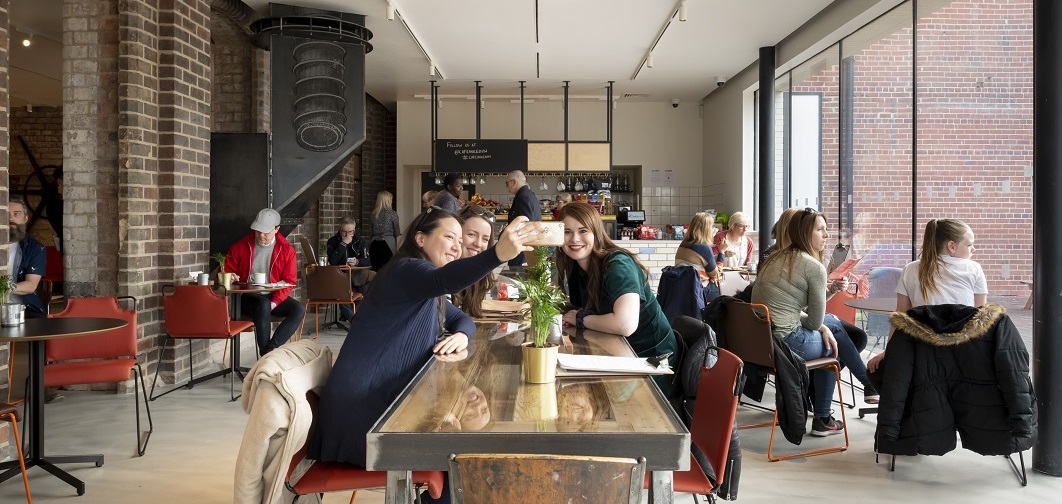Edinburgh Printmakers
-
 Location: Edinburgh
Location: Edinburgh
-
 Sector: Heritage
Sector: Heritage
-
 Division: Regional Building
Division: Regional Building
The redevelopment of this Grade C-listed building involved the refurbishment, alteration and extension of the 19th century Castlemill Works. This traditionally built, three-storey building, was formerly home to the North British Rubber Company between the wars and later became a store for Scottish and Newcastle Breweries.
Prior to the commencement of our works, the building had been vacant for over a decade and in a poor state of repair. The roof was suffering from extensive dry rot and many of its rare features, including 19th century polychrome brickwork and original detailing to the interior dating back to 1916, were hidden behind paint or in desperate need of preservation. The vision was to create a new space for the local community while keeping the historical legacy of the building. We returned the building to its former glory by:
- cleaning and repairing the brick
- treating rot infested historic doors and timber panelling
- recreating the original plaster
- conserving historic floor finishes
- fully restoring the 1916 listed staircase and upper ground floor
At a glance...

£6m
Project value

December 2018
Completion date

Edinburgh Printmakers
Client

Conservation works
Rot had been discovered throughout the original timber panelling, which was to be a finished feature. To avoid any damage during the construction process, we stripped the panelling from the outset and moved it off site. It was treated for rot at this location and then returned at the appropriate time. To retain the historical external brickwork, we used salvage brick to form the new structural opening and replace any existing bricks that had major damage. Where a brick had minor damage but could be saved, we utilised a Lithomix repair which was expertly coloured to match the existing brick. Internal bricks that were salvaged were used to create new features in the café/kitchen areas.
The salvaged brick leftover at the end of the project had important historical value as they are no longer manufactured and are difficult to source. Because of this, and the fact we didn’t want to send the brick to landfill, we agreed with the client and Heritage Scotland that the brick would be donated to other projects that required similar bricks.
Challenges and solutions
Challenge: whilst the removal of lead paint from existing columns was carried out by a specialist licensed contractor, we were still presented with the challenge of ensuring that lead dust was contained and fully cleared.
Solution: we segregated large sections of the building and created airtight seals to zones whilst the lead paint removal was undertaken. We operated strict controls and a permit system to ensure that all safe systems of works were in place and that there was no risk of exposure to site operatives.
Challenge: the new canopy lintels had to be installed above the new entrance and weighed over 800kg each. They were planned to be installed during the Edinburgh Fringe, one of Edinburgh’s busiest times of the year.
Solution: because this installation wasn’t on the critical path, we agreed with the supplier that they would be delivered on a later date to avoid the traffic from the Fringe. We applied for a partial road closure on Gilmore Park and had the 800kg lintels lifted over the building and lowered into place. This required a lot of co-ordination from multiple different sub-contractors to complete this within the time frame, while keeping everyone safe.

Maximising best value
We provided the client with a saving by using double glazed Pitchglaze Rooflights instead of the ones originally specified. This was suggested by our rooflight sub-contractor, who we have worked with on a number of jobs. This new rooflight provided a frameless internal view, and also allowed more daylight to enter the art studio in comparison to the original spec. During construction, we identified that the finish to a lot of areas could be achieved by ‘tape and fill’ rather than skim coat plaster. We brought this to the client’s attention, and they agreed this was a better approach for the project and it saved them a large sum of money.
Awards and recognition
-
 EAA Awards for Architecture – Regeneration / Conservation Project of the Year
EAA Awards for Architecture – Regeneration / Conservation Project of the Year
-
 RICS Social Impact Awards – Project of the Year
RICS Social Impact Awards – Project of the Year
-
 RIAS Awards – Zero Waste Scotland Circular Economy Award
RIAS Awards – Zero Waste Scotland Circular Economy Award
Our partners
-
Cost Manager: Doig + Smith
-
M&E Engineer: Harley Haddow
-
Architect: Page / Park
